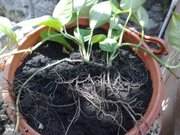Wednesday, March 27, 2013
Good Friday is traditionally the time for those who plant "by the signs" in central Mississippi to put seeds in the ground, but for most home gardeners, now is a good time to prepare seedlings (or "starts") for transplanting.
Until the soil warms and the last chance of frost is past, gardeners may find themselves surrounded by trays or cups filled with potting soil and seedlings. To maximize daylight, take the plants outdoors during the day and bring them in at night. An easy way to do that is to use a wheelbarrow--just wheel it out in daytime and wheel it back into the garage at night. Allowing seedlings outdoor time also "hardens" the plant, so it becomes accustomed to harsher conditions.
Seedlings start best with high-quality potting soil. Look for certified organic brands in local stores. Most commercial potting soil is a mix of peat moss, perlite and synthetic fertilizer. Not only is that not organic (the synthetic fertilizer part), but it's not Earth-friendly, because peat moss is most often derived from environmentally sensitive areas. So, what's an organic gardener to do?
Even Earth-savvy gardeners may not stop to think about it, but if you are composting, you have nearly half your potting soil issue already resolved. Essentially, the mix for potting soil should have water- and air-holding capacity and fertilizer of some kind. A common recipe for DIY potting soil for seedlings would be 40 percent compost mixed with 20 percent vermiculite or perlite (available at garden stores; both are inorganic minerals that provide structure and drainage) and the rest a light, air- and water-absorbing vegetative material, such as composted bark or coconut coir (a renewable resource).
Each recipe is as individual to the gardener as food to a chef. If you are a diehard homesteader, you can experiment with found materials, such as one part compost or screened leaf mold, one part garden topsoil, and one-third sharp or builders sand (some people use creek or river sand, but it may contain nematodes).
For more, visit jfp.ms/organicpottingmix.
Jim PathFinder Ewing is a journalist, author, writer, editor, organic farmer and blogger. Find Jim on Facebook or follow him @edibleprayers or @organicwriter or visit blueskywaters.com.
Join him at Rainbow Natural Grocery Co-Op (2807 Old Canton Road, 601- 366-1602) at 6:30 p.m. Sunday, April 7. Ewing will read and sign his newest book, "Conscious Food: Sustainable Growing, Spiritual Eating" (Findhorn Press, 2012, $16.95). High Noon Cafe will provide refreshments. Rainbow and the Conscious Living Project sponsors.
Avoid Hottest Part of Summer in the Garden
Something to consider when planting is when the plant will mature. Look on the seed package and it will tell you: 80 days, 90 days, 110 days, etc. So, if you want to be finished with your garden by August's sweltering heat, count back the number of days until fruition in choosing the varieties you want to grow.
Organic Root Stimulants
When planting a seedling, it helps to use a transplant agent. However, most on the market are not approved for organic growing.
The general rule is that if the Organic Materials Review Institute lists a product or ingredient, then it's OK for certified organic use. Root Tone product, for example, is not listed on the OMRI site, nor is its active ingredient, idole-3 butyric acid or indolebutyric acid. Neither is the other most popular ingredient on the market, napthalacetic acid. All are synthetics.
However, a number of organic root stimulators are approved, including products such as Hygrozyme and Biorhizotonic. For more, visit omri.org/ simple-opl-search/results/root or look up the name of the product. OMRI does not list synthetic products.
Farmers often have their own "secret" natural concoctions that may include fish oil, blood meal or other natural fertilizers. We use a mixture of water, kelp meal and fish emulsion. Just use your finger or a trowel to poke a hole in the soil, dip the roots of each start in the mixture and plop it in, gently patting the soil around it.
Native & Heritage Varieties Making A Comeback
Many Native American seed varieties once believed lost are making a comeback as popular interest in sustainability grows. Foremost in the field is Native Seeds/SEARCH, a nonprofit promoting seed conservation. It is focused on southwestern seeds, some of which work in the South, others not so well. Visit nativeseeds.org.
Another, for-profit pioneering company is Sustainable Seed Company. It actually sells certified-organic heirloom seeds (a rarity) and has been tracking down Native American varieties, selling seed corn derived from the Oscar H. Will company at the beginning of the 20th century. It also has a grain restoration project, bringing back diverse local grains. Visit sustainableseedco.com. For more on the topic, visit jfp.ms/nativeamericanseed.

